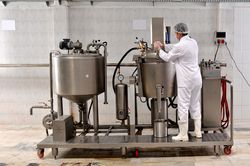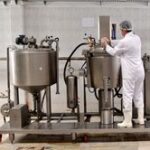Cows are milked daily, hence milk is delivered daily to the dairies by refrigerated trucks.
This milk needs to be stored at the dairies for anything from a couple of hours to a few days (for example weekends), before passing on to the processing and packaging line. Due to the high content of microorganisms in milk, it is necessary to pasteurize it and use refrigerated storage.
MachinePoint milk reception systems consist of a plate pasteurizer to reduce the amount of microorganisms in milk. Subsequently, milk is cooled and maintained at temperatures below 4 ° Celsius in insulated tanks.
Although milk is delivered in a short period of time, the processing and packaging of milk can take up to and over 24 hours. This means that there is a high demand for refrigeration during the delivery times. For those plants that do not have large-scale refrigeration equipment, we install ice brine ponds or ice ships that can be used when there is a high demand for refrigeration during the milk reception hours.
Milk reception systems, storage tanks, cooling systems, piping, etc, should be properly cleaned by a CIP system to guarantee process hygiene. CIP systems are usually automated into the production process so milk reception, pasteurization, storage, is all automated and monitorized. Companies that want the FDA 3A y EHEDG certificates need to have all their systems automated.
Frequently asked questions about milk reception units
A milk reception unit is a set of equipment used to receive and process fresh milk at a dairy plant. It operates by receiving milk from producers in refrigerated tanks, then undergoing pasteurization and storage in refrigerated tanks.
A milk reception unit is a set of equipment used to receive and process fresh milk at a dairy plant. It operates by receiving milk from producers in refrigerated tanks, then undergoing pasteurization and storage in refrigerated tanks.
Yes, milk reception units can significantly help in preventing the multiplication of undesirable microorganisms. This is achieved through pasteurization of the milk, a process that kills harmful microorganisms and extends the shelf life of the dairy product.
Temperature control during the milk reception process is crucial for killing bacteria. Maintaining the milk at specific temperatures during transport and storage helps prevent the proliferation of harmful bacteria, ensuring the safety and quality of the final product.
Yes, there are several types of machinery specifically designed for milk reception units. This includes pasteurization equipment, refrigerated storage tanks, cooling systems, and Clean-in-Place (CIP) systems to ensure process hygiene.
Milk reception units can be integrated into existing dairy processing facilities by installing appropriate equipment and adapting milk handling and storage systems. At MachinePoint, we offer specialized advice for efficiently integrating these units into our clients’ facilities.





